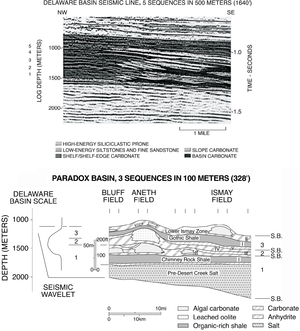Difference between revisions of "Seismic scale importance"
FWhitehurst (talk | contribs) m (FWhitehurst moved page Scale importance to Seismic scale importance: most important term first; vague) |
Cwhitehurst (talk | contribs) m (added Category:Treatise Handbook 3 using HotCat) |
||
| (3 intermediate revisions by the same user not shown) | |||
| Line 6: | Line 6: | ||
| part = Predicting the occurrence of oil and gas traps | | part = Predicting the occurrence of oil and gas traps | ||
| chapter = Exploring for stratigraphic traps | | chapter = Exploring for stratigraphic traps | ||
| − | | frompg = 21- | + | | frompg = 21-9 |
| − | | topg = 21- | + | | topg = 21-9 |
| author = John C. Dolson, Mike S. Bahorich, Rick C. Tobin, Edward A. Beaumont, Louis J. Terlikoski, Michael L. Hendricks | | author = John C. Dolson, Mike S. Bahorich, Rick C. Tobin, Edward A. Beaumont, Louis J. Terlikoski, Michael L. Hendricks | ||
| link = http://archives.datapages.com/data/specpubs/beaumont/ch21/ch21.htm | | link = http://archives.datapages.com/data/specpubs/beaumont/ch21/ch21.htm | ||
| Line 16: | Line 16: | ||
==Scale and data type== | ==Scale and data type== | ||
| − | [[file:exploring-for-stratigraphic-traps_fig21-4.png|300px|thumb|{{figure number|1}}. Copyright: Sarg, 1988 | + | [[file:exploring-for-stratigraphic-traps_fig21-4.png|300px|thumb|{{figure number|1}}Comparison of Pennsylvanian ({{Ma|Pennsylvanian}}) carbonate reef margin depositional sequences from the [[Delaware basin|Delaware]] and [[Paradox basin]]s, U.S.A. Copyright: Sarg;<ref name=Sarg1988>Sarg, J. F., 1988, Carbonate sequence stratigraphy, in C.K. Wilgus et al., eds., Sea-Level Changes—An Integrated Approach: SEPM Special Publication 42, p. 155–181.</ref> courtesy SEPM.]] |
Correlations with well data, such as cuttings, cores, or well logs, can be done to a much higher resolution than seismic scale correlations. The scale of a seismic wavelet limits the scale of correlations within a seismic section. The geologist must refine these correlations to a higher resolution using well data to more accurately define the location of seals and reservoirs. | Correlations with well data, such as cuttings, cores, or well logs, can be done to a much higher resolution than seismic scale correlations. The scale of a seismic wavelet limits the scale of correlations within a seismic section. The geologist must refine these correlations to a higher resolution using well data to more accurately define the location of seals and reservoirs. | ||
| Line 27: | Line 27: | ||
* [[Stratigraphic trap seals]] | * [[Stratigraphic trap seals]] | ||
* [[Diagenetic impact on traps]] | * [[Diagenetic impact on traps]] | ||
| + | |||
| + | ==References== | ||
| + | {{reflist}} | ||
==External links== | ==External links== | ||
| Line 35: | Line 38: | ||
[[Category:Predicting the occurrence of oil and gas traps]] | [[Category:Predicting the occurrence of oil and gas traps]] | ||
[[Category:Exploring for stratigraphic traps]] | [[Category:Exploring for stratigraphic traps]] | ||
| + | [[Category:Treatise Handbook 3]] | ||
Latest revision as of 21:06, 3 February 2022
| Exploring for Oil and Gas Traps | |

| |
| Series | Treatise in Petroleum Geology |
|---|---|
| Part | Predicting the occurrence of oil and gas traps |
| Chapter | Exploring for stratigraphic traps |
| Author | John C. Dolson, Mike S. Bahorich, Rick C. Tobin, Edward A. Beaumont, Louis J. Terlikoski, Michael L. Hendricks |
| Link | Web page |
| Store | AAPG Store |
Scale and data type

Correlations with well data, such as cuttings, cores, or well logs, can be done to a much higher resolution than seismic scale correlations. The scale of a seismic wavelet limits the scale of correlations within a seismic section. The geologist must refine these correlations to a higher resolution using well data to more accurately define the location of seals and reservoirs.
Scale and trap detection
Scale makes a difference in ease of detection and, hence, affects risk. In Figure 1, Pennsylvanian (323.2 Ma) carbonate reef margin depositional sequences from the Delaware and Paradox basins, U.S.A., are compared. Note the difference in scale and how it affects seismic interpretation. Seismic detection of the Paradox basin traps is much more difficult because of the wavelength of the seismic wave vs. the reservoir thickness.
See also
References
- ↑ Sarg, J. F., 1988, Carbonate sequence stratigraphy, in C.K. Wilgus et al., eds., Sea-Level Changes—An Integrated Approach: SEPM Special Publication 42, p. 155–181.